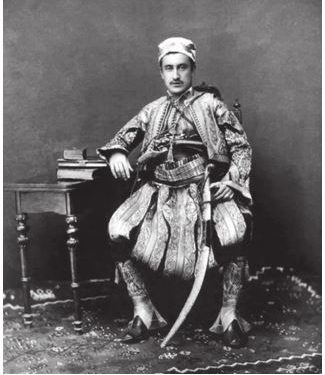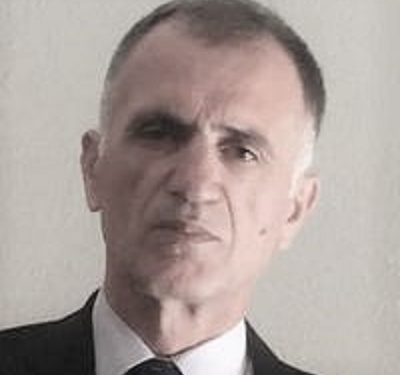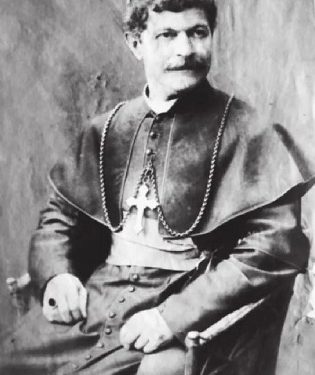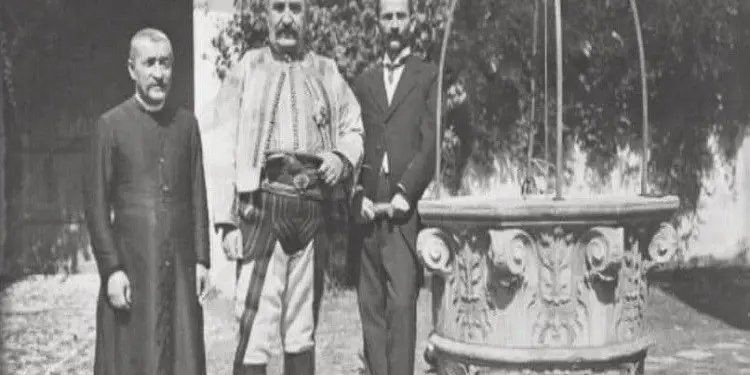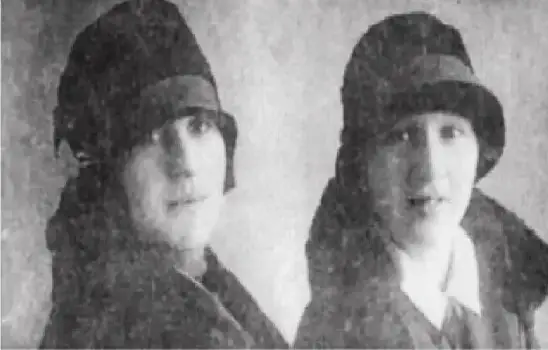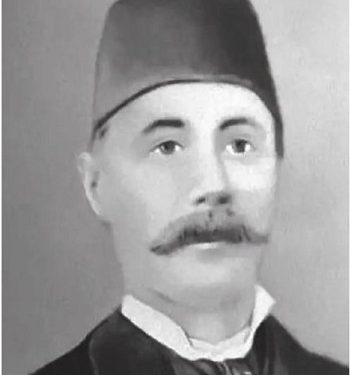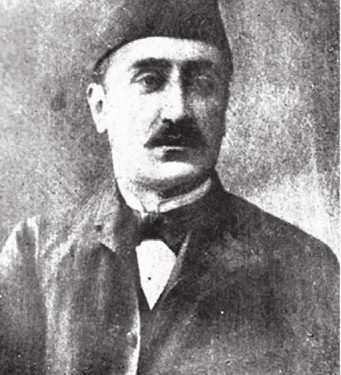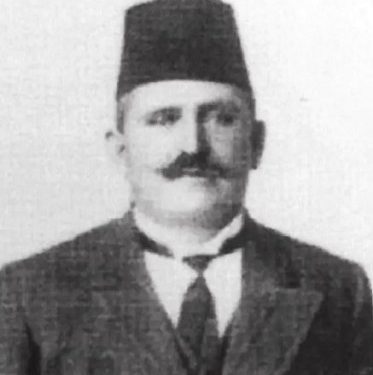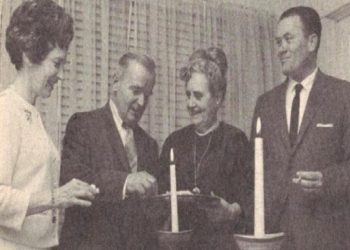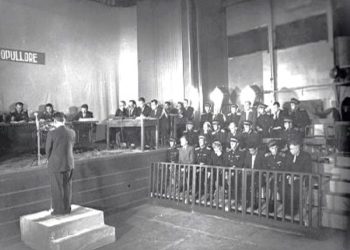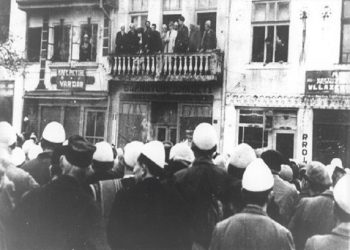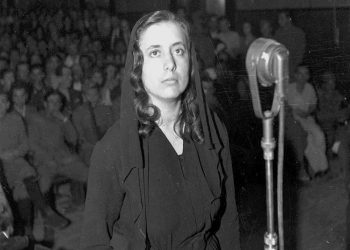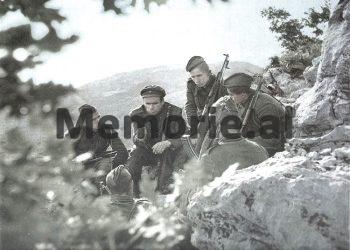By Dr. Nikol Loka
The fourth part
“PRENGA BIBE DODA, THE SHADOWS OF A CITIZENSHIP”
Memorie.al / The newest book “Prengë Bibë Doda, a phenomenon in Albanian political life”, by the researcher Nikollë Loka, not only expands the field of historical studies on Mirdita, the Door of Gjonmarkaj and the figure of the Mirdita Prince, Prengë Bibë Doda, but it is also a contribution to national historiography. The very rich archival material, the literature used or consulted, oral traditions, etc., make this book a real study treasure, giving the science of history a scientific monograph that enriches our knowledge of Mirdita, its captains, tradition, history etc. To study such an important and complex figure, as the figure of Prengë Biba Doda, is a high scientific responsibility that not everyone undertakes. Nikollë Loka, has done a great job of research and treatment by the professional researcher, giving us the portrait of the Prince and the general Mirditor, with the true contours. Loka has adhered to the end of space and time, in which the multidimensional events and their protagonists have unfolded.
THE MONOGRAPH “ABOUT BIBË DODA, A PHENOMENON IN ALBANIAN POLITICAL LIFE”, A VALUABLE SCIENTIFIC STUDY THAT ENRICHS THE FUND OF OUR HISTORICAL STUDIES
(By Mr. Sc. Murat Ajvazi, March 2017, Switzerland)
Continues from last issue
For everything that was no longer related to their duty, the elders of the village and the bajrak were the same as the other members of the tribe. There were no privileges, as in the feudal or party system. Their blood had the same value as that of the poorest shepherd and they were subject to the same penalties. They too had to find bail bondsmen, who guaranteed the improvement of their behavior, like any simple member of the tribe. They had to go out with a rifle in hand, like everyone else, when it was necessary and they had to participate in public affairs, ordered by the bajrak and the village, such as; maintenance of roads and canals.
The only privilege; that the elders and leaders had, according to the hierarchy of their positions, was a place in the “corner” of the table, as a place of honor, the ram’s head and the first coffee, always; when the house had no friend of higher rank than he. In terms of legal matters, elders and chiefs weighed more heavily than other members of the tribe. If, for example, an elder had to appear as a witness to an oath, for which twenty-four witnesses were needed, his testimony was valid for twelve people. In the assemblies of the people, no important decisions could be made, regarding the tribal unit, without the presence and approval of its chiefs and elders. They were also judges over the Bajraktars. (47)
Unlike the other bajraks of Mirdita, Oroshi has only had three great elders of the bajrak: the head of Gegë Doda i Marpepaj, the first elder; of Bush i Markolaj, second elder and of Kola Djuta, i Dedaj, third elder. Bush’s and Kola’s Shpia represented the tribes of “eighty houses” and the house of Dodë Gega, representative of “fifty houses”.
The tribes of Oroshi formed at the end of the 17th century the bajrak with the same name, which is the first bajrak in Mirdita and therefore had priority in the implementation and interpretation of the Canon of Leka. In any case, that the other Bajraks had any disagreements between each other, on border issues or other important issues, they took one of the orosha as an elder to judge and resolve the issues. The popular expression still remains today; “For a penny, take the old man to Orosh”. The old man in Orosh was taken when the old men of the country did not agree and the issue remained unresolved by them. When any of the other Bajraks did not think the decision given by the elders of the country was right, or was suspicious about it, he went to Orosh, to ask or to clarify, and the Oroshans have considered them as the most smartest and most competent, among the bajraks of Mirdita. These everywhere have occupied the top of the country. (48)
This superiority has remained with Oroshi as the first brother, among the first three bajraks of Mirdita. Father Zef Valentini, writes that; “the highlanders of Oroshi feel more prominent than those of other Bajraks; their clothes are cleaner, in their relationships with others, they are more elegant and it shows from the face, courtesy and sincerity”. (49)
This behavior was formed in the conditions where the Customary Law itself reserved a special treatment. At weddings and disasters, at receptions and assemblies, the oroshasi occupied the head of the country. Oroshas also had more opportunities to participate in important assemblies and eldership duties. Through the Capitan, they presided over the zabitnamen, for the reconciliation of bloods and entanglements. (50)
Of course, that position had to be justified with skill, that’s why every Orosha tried as much as he could to learn to direct and give way to conversation.
Being the first bajrak of a province with a great name, Oroshi, he was respected by all the mountains of Gegeria. According to the Canon of Lekë Dukagjini, in Mirdita’s version “the mountains of Dukagjini, from Lezhe to Prizren, the top of the country in the middle of Prije, have Oroshi and Gjomark, were brought together. The bajrak of Oroshi has the first place among the bajraks of Dukagjin. While in the mountains of the North: Dukagjin and Malësi, Hoti of Shkodra takes the lead, and Oroshi comes immediately after him. (51)
MARKOLAJT OF OROSHI
The Markolaj of Oroshi is a much mentioned tribe, because from one of their branches, the Gjonmarkaj of Mirdita was formed. Father Zef Valentini describes Markolaj as a brotherhood proverbially known for using the sword. (52)
Regarding this tribe, Dom Nikolle Kimza, writes: “The first among the tribes of Oroshi is the Markolaj tribe, and of this tribe are the Gjomarkaj and Bajraktari with their own spears.” (53) Word of mouth conveys the memory that; “the creation of Oroshi started with the tribes: Markolaj, Dedaj, Dodaj in Kodë Kolike, where there are the ruins of the old town, where it is said that the Mirditas first had their occupations here”. (54)
“The tribes and their bellies have come to you, created and developed after your time and distribution, in the valley of Gryka Oroshi and up to the border with Kryezez of Malcia Lezha, in Livadhe, to find arable land”. (55)
“Markolajt, include Bush and Lulin, who are considered on the side. Not all Markolajts have blood relations between them”. The Luli and Bushi brotherhoods, thought to be the oldest in Orosh, are supported by the Markolaj, however the Markolaj must have arrived early, because they met to enter into an agreement with the old tribes found in the country, becoming brothers hang out with them.
In Mirdi, seniority is a significant indicator of nobility. The canon of Lekë Dukagjini clearly defines the position of the one who came earlier in a place: “The old spire is the old spire in the town of Dhé. This is the foundation, but of its own shell. The old spear, whether it’s small or big, has the honor of being the foundation spear, from the spears of its own generation. (56)
Sali Vuçiterni, based on a document, for which he does not tell us the source, writes that; “the house Markolaj (Marpalaj), great-grandfather of Biba Doda, together with others, came from Pashtriku i Gjakova in 1633 and settled in today’s Mirdita”.(57)
Elders from the beginning of the last century, told with conviction that the ancestors of the family of Prengë Biba Doda of Oroshi, had their properties in Pashtrik and Rrafsh i Hasi, inherited since they came from there and received rent for grazing on the mountain of Pashtriku and, in their lands in Has of Rrashfi, rent that was terminated in time. (58)
Zef Mark Harapi, who collected the legends in the country, around 1930, when he served as the director of the Oroš Dormitory, brings out Gjomarkaj, with origins like all other Oroš residents. “In 1931, Çup Kolë Skana, from the Skana tribe from Oroshi, told me that in Pashtrik, there is a tribe called Marosh, with Muslim faith, and one of the tribe is called Sherif Maroshi, a very rich man for that province, he came in 1921 to Orosh, to the house of Gjomarkaj, to spend a few days with me for fun, as cousins of the same tribe. The origin of the name Orosh, therefore, is said to come from the name Marosh, although another legend says that the name Orosh comes from Varosh i Gjakova. The words of the wise old man, Čup Kolë Skanes, I think should be taken more as a basis. In the same way, Prengë Kola, the brother of the famous Komi in Kosovo, Zefiti Vogël, originally from Fani i Mirdita, but with permanent residence in Gjakovë, also said. (59)
There are researchers who connect the name of the village of Orosh with the name of the Marosh tribe. (60)
But, despite being from the same tribe, due to their prominent identity, the Gjomarkaj separate them from the Markolajt, or at least, treat that common ancestry as something of little importance to them, since the glory of the Door of themselves, they won it when they became known as Dera e Gjonmarku. This is expressed best by Ndue Gjonmarkaj, son of Gjon Marka Gjon, when he answers Mustafa Kruja, regarding Markolajt e Oroshi. In response to the questions of the erudite intellectual, Kruja, about Markolaj, Ndoi shows little knowledge and little interest in Markolaj, as he cares and is enough, being like Gjomark. Ndoi begins his answer to Mustafai with a question, which means that even he, an educated man with interests in knowing the antiquity of his Dera, does not know, or is not interested in the involvement of Gjinmarkaj in Markolaj. Ndoi writes to Mustafa: “The name of the Markolaj tribe comes from, after all, we Gjonmarkaj are also from that tribe, but we are Gjomarkaj as well.
You say, it’s not possible, with the name Markolaj, from Marka Kolë Palit, to John Marka Kolë Palit? If not, from this, where could it flow from? (61)
While Mustafa Kruja, before giving him an answer, asks him for some clarifications: “They gave me a judgment, more or less close to the truth about them, in relation to my family, you need to answer me first you: “What do Markolajt believe about themselves? What do the people of Oroshi believe about them? What about you Gjomarkaj? Are they a big tribe”? (62)
After receiving those clarifications, Mustafa Kruja sent the answer to Ndoi: “Markolaj, they do not come from John Mark Kolë Pali, but those who are called Markolaj and Gjomarkaj today, are from the same tribe. The great history of Gjonmarkaj begins with Gjon Marka Kola Palin and Mark Kola, who gave the whole tribe; he was not a well-known person”. (63)
Apparently, Mustafa Kruja was not talking about John Mark’s father, the well-known head of Oroshi, Marka Kolë Palin, who at the head of the Mirditas, agreed to go to war on behalf of the Turks, but about a Marka Kolë, ancestor of him, who is thought to be the first of the tribe. The age of a tribe in a particular settlement played a role in determining the social position of that tribe, and all the families forming each tribe are alike brothers and cannot be considered essentially different in rank, but only in rank age and efficiency. Some families have more influence than others. These families acquire the role of the head, i.e. of priority, or at the highest level, of leadership…! (64)
Brenda Markolajve, a tribal elder, is Bush’s spearhead, due to her seniority, as a sidekick. Despite the fact that the Markolajt, as a tribe, enjoy the same social position in Orosh, the Gjomarkajt gained a special position, among other brotherhoods of the tribe, because it was Marka Kolë Pali and especially his son, Gjon Marku, who rose a lot in the rank social and naturally that rank, benefited only his descendants.
The tribe of Markolaj has the sounds: Gjomarkajt, Bushi, Bajraktari, Topalli, Luli, Curri, Marëpërndrecajt, and Gjokë Llesh Doda. From this tribe, three voices are distinguished: Gjomarkaj, the first of all Mirdita, Bushi, the first of the tribe, who is part of the 25 chiefs of Mirdita, and Shpia of Bajraktar, who is also part of the 25 chiefs. From this it follows that; Markolajt, are the most represented tribe in Mirdita, with two heads of Gjomarkun, when all the other tribes of Mirdita had 22 heads together. It should be mentioned that; Luli, the Anas Island, found in Orosh, supported by Markolaj, has a name because of its antiquity. Bushi and Luli, gave the Markolajs the seniority tag, which, based on the Customary Law, created an opportunity for the Markolajs to acquire the right of prey. In 1637, Marka Kolë Gjoka, (65) of Markolaj, the father of the famous John Mark, who is thought to have first received the title “Kapidan”, is mentioned as Qefali i Oroshi. As Kapidan, he initially performed only the functions of the military commander for Mirdita’s forces and was Chief only for Orosh, but then he also received the rights of the chief for the three Bajraks of the tribe. In those conditions, as a tribal elder, the Bush family became. Markolaj, through Bush, has the second elder, because Marpepaj has the first elder, through the house of Gegë Doda.
The claim they had for the Head of Oroshi and the rivalry with Gjomarkaj, Marpepaj, they support in the right of the first, since according to them; “they are among the newcomers, the oldest in Orosh”. In fact, as protagonists of the developments in Orosh and throughout Mirdita, there have been Gjomarkaj of the Markolaj tribe and Gegëdodaj, of the Marpepaj tribe, as representatives of two different tribes: six tribes of the “eighty islands” and as many other tribes, of “fifty houses”. Even the representation in the Assembly of Chiefs of Oroshi has had the character of factions, where both groups clashed with each other to solve problems; therefore they always had to reach an agreement, which was accompanied by mutual concessions. The late tribal organization in Orosh shows that the Markolajs left the function of the Chief (Vojvoda of Orosh) to the Marpepajas and the right to the first place, on the side of the fireplace, inside Orosh. The old say that; “in Orosh, in its own bajrak, the spire of Gjomark; occupied earlier, always the second place…”! (66)
Of course, by the word “earlier”, the author has in mind a past time, probably a hundred years ago. In the years 1735-1737, Marka Kolë Gjoka was the Head of Oroshi and probably he and his tribe, at that time, occupied the head of the country, since he did not have a higher function than the Head (Head) at that time. According to legend, the Markolaj found Bushi and Luli in Orosh, whose origins are unknown, while the Marpepaj found Skana, who is said to have come from Kruja. Based on custom, Markolajt with Bushi and Luli in their composition, won the right of the oldest tribe, due to the fact that Bushi and Luli, who were known as Markolaj, were considered older than Skana, who found Marpepa, after Skana is known to have an earlier origin and is known to have been non-native. Memorie.al
The next issue follows
- Walther Peinsipp, The People of the Mountain Albanians,… p. 64-65
- Kolë Shtjefni, Ethnic Mirdita,… p. 61
- Father Giuseppe (Zef) Valentini, The Law of the Albanian Mountains, “Plejad”, Tirana 2007, p. 238
- Xhemal Meçi, The Canon of Lekë Dukagjin in the variant of Mirdita,… p. 25
- Xhemal Meçi, The Canon of Lekë Dukagjin, variant of Mirdita,… p. 101-102
- Luigj Martini, Bibë Doda,… p. 39
- Dom Nikollë KImza, Investigations on the antiquity of the Door of Gjonmarkaj of Mirdita, p. 347-349
- Zef Marka Harapi, Mirdita in history and gojdhana until 1929, Hylli i Drita, No. 1, 1931, p. 41
- Kolë Shtjefni, Mirdita ethnic… p. 59-63
- Xhemal Meçi, The Canon of Lekë Dukagjin in the variant of Mirdita,… p. 38
- Mark Tirta, Migration Movement of Albanians, p. 183
- Zef Marka Harapi, Mirdita in history and gojdhana until 1929, Hylli i Drita, No. 1, year 1931, p. 41
- Zef Marka Harapi, Mirdita in history and gojdhana until 1929, Hylli i Drita, No. 1, year 1931, p. 41
- Zef Marka Harapi, Mirdita in history and gojdhana until 1929, Hylli i Drita, No. 1, year 1931, p. 41
- Mustafa Merlika-Kruja, Assembly of letters with friends, Omsca-1, Tirana 2014, p. 85
- Mustafa Merlika-Kruja, Assembly of letters… p.110
- Mustafa Merlika-Kruja, Assembly of letters… p.117
- Father Giuseppe (Zef Valentini), The right of communities in the Albanian legal tradition, “Plejad” publications, Tirana 2007, p.16
- Nikollë Loka, Prengë Bibë Doda i Mirdita, the light and shadows of a statesman, Geer, Tirana 2010, p. 23.
- Pal Doçi, Self-government of Mirdita, Tirana 1996




